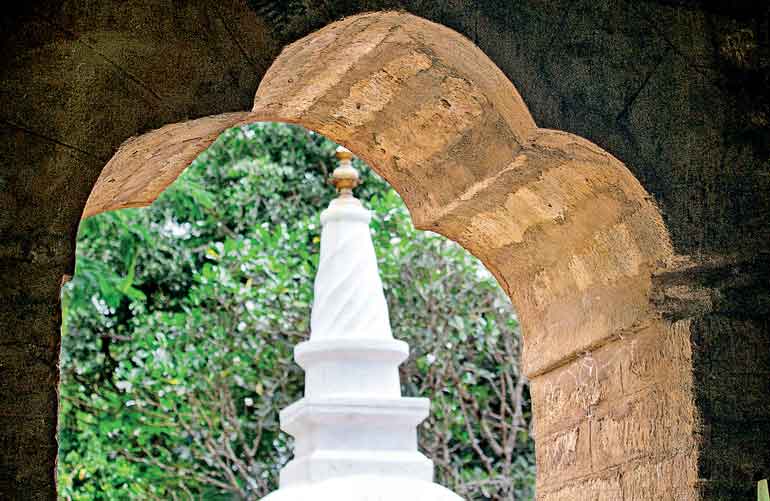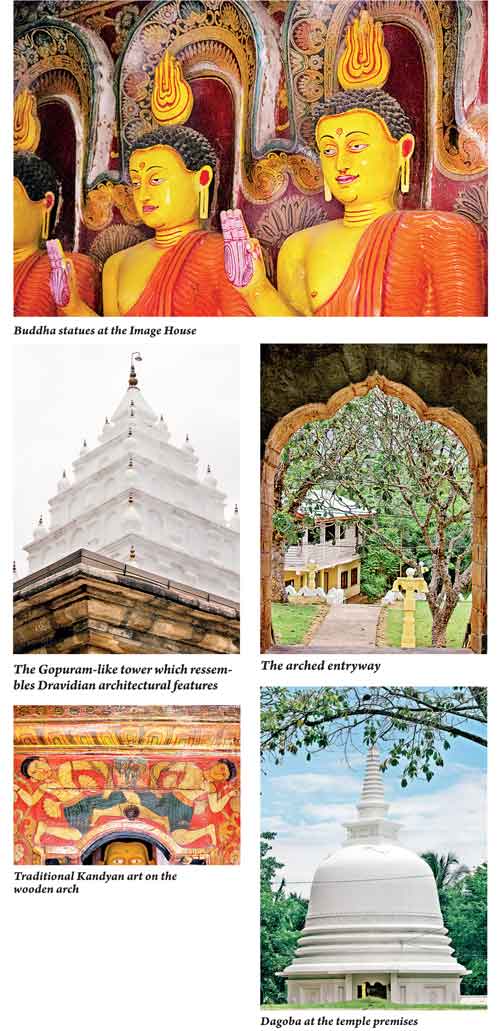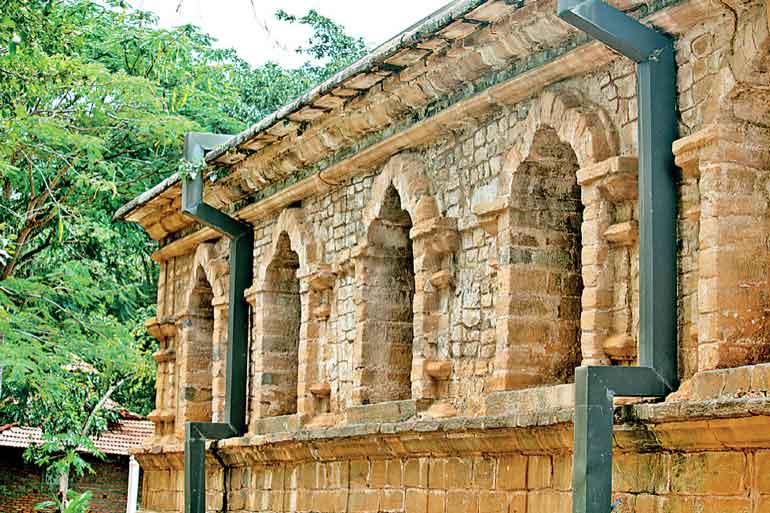Tuesday Dec 30, 2025
Tuesday Dec 30, 2025
Saturday, 21 October 2017 00:01 - - {{hitsCtrl.values.hits}}

By Aysha Maryam Cassim
Galmaduwa Viharaya on Kundasale Road is an unfinished stone temple that combines both Hindu and Buddhist architectural features. It is an edifice that exhibits the excellence of massive stone and brick masonry that existed during the Kandyan Kingdom of Sri Lanka. 
If you circle around the outskirts of country roads in Pathadumbara, Kandy, head to Nattarampota Kalapuraya. Just two minutes on foot from the craft village you will come across the magnificent façade of Galmaduwa Viharaya.
The outermost entrance of the temple has a Gopuram (tall pillar). J.P Lewis, says that the “Galmaduwa Viharaya probably enjoys the unique distinction of being the most Hindu-looking Buddhist temple in existence”.
Maduwa or Mandapaya in Sinhala is a pavilion. The lower storey of the Mandapaya is built out of stone and the upper storeys are made of mud bricks, stone, and granite. Since the pavilion is entirely made of (gal) stones, it is believed that the name Galmaduwa came into use.
It’s difficult to procure archaeological evidence on the history of this temple. Old bricks engraved with Brahmi script found in the temple premises prove that there had been an ancient Dagoba at this site. The only authentic sources available come from folklore and reports written by British civil servants who served in Ceylon during the 19-20th century.
A.C Lawrie was an eminent British District Judge of Kandy who later became a judge of the Supreme Court. In his book, Gazetteer of the Central Province of Ceylon, Lawrie refers to this temple as the Galmaduwa Gedige Vihare, also Galapita-ambe Vihare and describes it as “a very curious building built in the style of a Tamil Hindu temple”.
Following the ideals of Buddhist Kingship, Kirti Sri Rajasinghe (1747-1780) identified himself as a righteous king devoted to the revival of Buddhism. While consolidating his power, he demonstrated his inclusiveness in all cultural spheres. Not only he gave his generous support to build monastic schools and educational institutions, but he also restored Hindu temples with a Buddhist outlook and recommenced religious rituals.
There is a rather intriguing story as to why the temple was never finished. Built by King Kirti Sri Rajasinghe, historical evidence suggests that while this building was being designed, the King was informed that construction of the 80-feet-long, 80-feet-high stone edifice was nearly completed, he suspected that this was an assassination plot and ordered that work must be halted. Then he heard of the discovery of a cave at Degaldoruwa and suspended the construction work on Galmaduwa forever.
Although Galmaduwa is known as an ordinary place of worship, this stone edifice has not been completed since the demise of Kirti Sri Rajasinghe. Around 1900, upon discovering the dilapidated state of the temple, Pethiyagoda Vipassi Thero renovated it with the help of his Dayakas.

Folklore further says that Kirti Sri Rajasinghe who bought a plan from North India built this temple with the assistance from Meegasthanne “Adikaram”. In the interior of the pavilion, there is an Aasana (Image altar). Near the eastern building, there is a Viharaya which was built approximately 125 years ago. Since the villagers were unable to raise funds to complete the main temple, they erected a Viharaya to compensate for the unfinished structure. The Vihara Geya in Galmaduwa houses a marble seated Buddha along with 24 other Buddha statues from the Kandy Era.
The pavilion is surrounded by a massive wall with an overhanging and deeply molded cornice. The most striking features of the interior are the five windows pierced into the walls on three sides. The central window, which is of slightly larger dimensions, stands as the entrance. There are but two doorways, one into the enclosure and one opposite it into the sanctum.
The construction of the upward edifice become smaller from bottom to top, in the form of a Vimana (mansion). This architectural element strongly resembles the Gedige tradition which can be found in Shiva temples in Polonnaruwa and Nalanda Gedige, Matale. The Gedige shows features of Thanjor architecture as well.
The semi-circular cusped arches with a keystone of the wall exhibit Persian characteristics. A villager in Nattarampota, Kalapuraya told us that the interior of Galmaduwa temple pavilion had been used as the backdrop of Rani Sandalwood Soap advertisement in which the elegant ‘Rani’ – Queen – appears through the ornate stone arched windows.